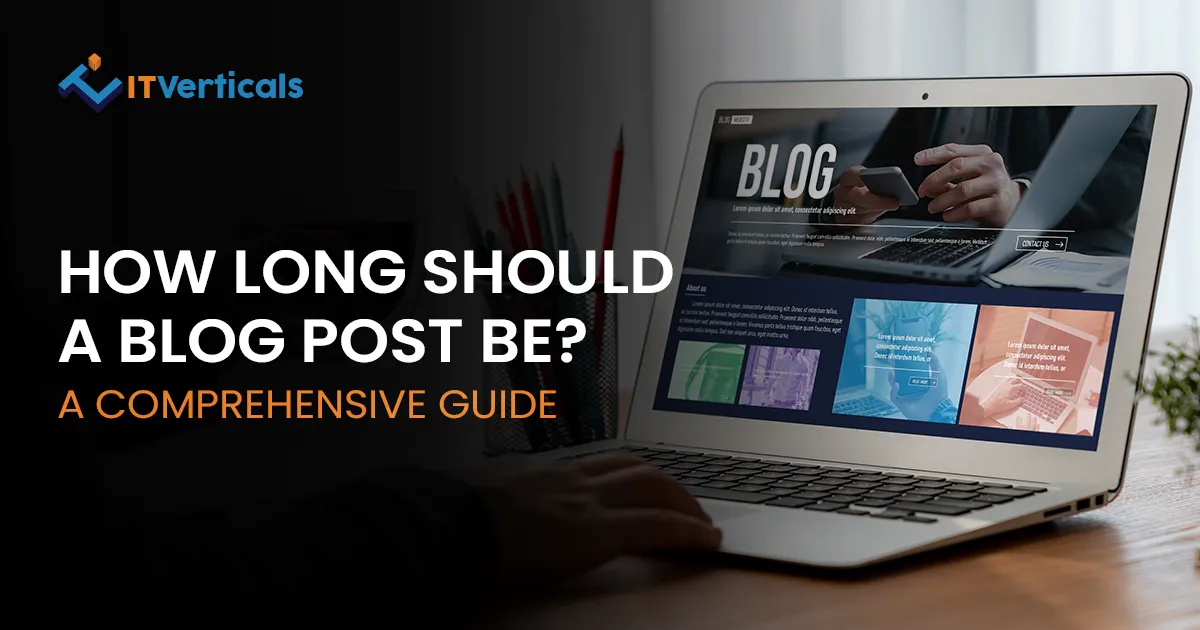
- admin
- April 3, 2025
- No Comments
The world of content writing is transforming! It is revolutionizing with the dawn of the technological age. Writing a blog post is actually an art. It is the best way to share your opinions or ideas. It is crucial to learn how to write a blog post before actually writing one. This is because of the technological takeover of the content. As per one of the trusted sites for blogs, approximately 7.5 million blogs are written and published every day. And with the rise of generative AI, this number is now continuously increasing. Content bloggers are now more prone to using generative AI for generating ideas and completing the whole blog. They now tend to give less attention to the content and the blog post length. The length of the blog post should be given equal consideration as the content and topic relevance of the blog.
Actually, the length of the blog post depends on various elements of the article such as the type of keyword, user persona needs, and intent of the search. But it is really essential for each and every blogger to know exactly how many words should be in a particular blog post. In the current day, expert content writers pay precise attention to the detail and exact length of their blogs. This is because the expert writers understand the need for the content of the blog to be well versed with the topic, especially at an optimized length. The length of the blog comes with content ideas. The topic of the blog determines how lengthy it should be as per its target audience.
Although, the ideal blog post length is subject to variation. Still, the most trusted sources on content writing state that the ideal and average length for blog posts lies between 1,500 – 2,500 words per article. This bracket is quoted by most of the sites, while other sites revolve around the upper and lower bound of this range i.e. somewhat close.
However, it does not justify that this range is best for each and every type of blog posts. Every blog has its own ideal length as per the topic relevance and the type. Read through this entire blog to know every bit of detail regarding the ideal length of the blog post. Help yourself by writing a perfect blog.
Why Does Blog Post Length Matter?

Blogs play an important role in bringing more audience on the website through internal and external linkages. The blog post length matters because in order to cater to a respective audience, the number of words should have some relevance to the topic. This means that the length of the blog should be as per the demand of the topic i.e. whether a reader would wish to read or want such in-depth detail on the specific topic.
The failure or success of the blog content may be dependent on the blog post length. This is because the detailed articles perform much better on Search Engine Result Pages (SERPs) than short length articles. Due to the in-depth content in the blog, the search engine considers the blog more credible. Hence, it prefers lengthy blogs more than other articles. That is why the length of a blog post matters a lot.
The lengthy content blogs tend to keep 40% of the readers engaged longer on the article, as per some sources. This is because, firstly, it does need time for the reader to complete reading a long-form blog. Second, the in-depth content tends to cater to the audience that are pleased with and want complete details on the topic. This type of audience resists short and concise blogs. Short form blogs feel like answers to FAQs.
Moreover, the blog post length also helps in competing with rival websites. A long-form blog on your website automatically be considered of higher value. The short-form blog on the same topic by a rival website will not be considered more credible, then. The blog post length allows the writers to adjust their content as per the number of words. They can easily tweak their content from a short and brief article to an in-depth blog with thorough details on the topic of choice.
How Long Should a Blog Post Be for SEO Point of View?

A blog could be of different categories. Each blog written on the brand’s own webpage is called a value blog. A blog written on a hosting website is called a guest blog. It is very crucial that the writers are aware of “how long should a blog post be for SEO”. Every writer and business must be aware of what SEO is. As per SEO point of view, the ideal blog post length is around 2000 words should. This is because the blog post’s length, structure, content, relevance to the topic etc. helps the website to uplift and rank higher on Search Engine Result Pages (SERPs).
The search engine algorithms are really careful about what it provides to the audience searching for a specific keyword. Hence, mostly it is those long-form blogs that the search engines feel more credible. The search engine algorithms give these lengthy blogs more weight and automatically ranks the websites higher on the result pages.
The search engines are always interested in rewarding the web pages with higher rankings that provide relevant and comprehensive information on the topic. This compels the writers to use easy and complex on-page SEO practices as they will get the blog posts ranked on top pages.
SEO enhances and improves the content through relevant keywords organically and allows for more backlinks and social shares. This creates an authority for the writer or the website which the search engine algorithm picks up and realizes the credibility of the website to rank it higher. Hence, it is equally crucial for the businesses to invest in SEO.
Ideal Length for Blog Posts of Different Types!

Blogs could be defined in different categories, but there are different Types of blogs as well. The ideal length for blog posts of different types does vary. This is because different types of blogs require different structure, keywords and length as per the topic and category. But the ideal blog post length does not vary too significantly. It tends to range in between the recommended length for all types of blogs as well, not just categories.
Each type of blog must be written with quality and relevant content. There should be optimized structure, use of highly searched keywords and optimum length to be ranked on top and grab the reader’s attention for a longer period of time. Various types of blogs are there that have different recommended blog post lengths
Length for Pillar Pages
In the Cluster Model, there are several Main topic pages. These pages are a part of this strategy and are known as Pillar pages. These pages further divide into numerous content pages which relate back to these pillars and each other. The ideal length for Pillar pages is from 2000 – 3000 words. The Pillar pages consist of detailed and thoroughly written content on a main topic. This content then further opens the door to and directs multiple short articles. These articles are written on connecting sub-topics of the main topic. There are specific keywords used in these articles that link back to the main topic on the pillar page. The length of these short articles is around 1000 – 2000 words.

This model basically helps in writing content on broad topics that have multiple sub-topics to be explained. The pillar page is the main center of content for the broad topic. The content on Pillar pages is in a longer format. This is because they are meant to cover more content than an average article. They are meant to have more internal links that link back to various other relative blogs on the website. The content on Pillar pages mostly tends to satisfy or meet the search intent and rank on top pages, quite easily. This is because of the fact that it has detailed content written on it, which builds authority. Also, as there are numerous and relevant keywords used in the content, with high internal and external linkages as well as backlinks which helps in this achievement.

Length for Listicle Blog Post
Listicle blog posts are pieces of content with list format. The topic/heading of these blogs mostly starts with “top” or “best”. The article lists down different items under one heading.
These items are then given a brief or detailed description, separately, that gives relevance to the topic. The recommended blog post length with this content format is well under 2500 words. The listicle blogs require more examples to effectively describe each element listed in the content. The images, links, and in-depth information on each subheading adds up to the word count. This allows detailed content on the blog.
The examples help in engaging the reader as the examples taken are mostly from the practical walks of life and not imaginary. The listicle blogs are meant to provide a wide range of options for various topics. These could include different types of tools, resources, organizations, ideas etc. An example of a listicle blog post is “Best Marketing Channels In 2024”. The recommended length in this format helps people develop a clear understanding of the topic. Instead of writing all items in a note format, the list format breaks down information in a clear and detailed way. The recommended blog post length helps in building trust among the readers for the content. This is because people tend to see the value provided through detailed content, which itself is not an easy task given that it requires a lot of research.
Length for “How to” Blog Posts
The blogs that provide content in the form of step-by-step instructions to the readers are known as “How to” blogs. These are written to give clear information on how to perform a certain task or activity.
Other than performing any task or activity, these articles also brief on the possible ways or steps of achieving a specific result. The recommended blog post length of “How to” blogs is somewhere around 2000 words. But the ideal length for blog posts depends upon the topic. The ideal blog post length could vary depending on what exactly is the reader being taught how to do. If the topic is small and the details of which can be covered in brief description then these articles can be written in around 500 words.

The length of the content builds credibility and the algorithm of the search engine trusts the authority of the domain hence ranking the blog on top pages. “How to” blogs are mostly written to help the reader in solving a complex problem or learn a new skill. The minimum best length of a blog post is recommended because it can easily cover the in-depth guidelines, brand service focus, and quality as the search engine algorithm trusts a longer format content more than the shorter format content.

Length for “What is” Blog Posts
The blogs that are written for educating readers about specific topics, terms or concepts are called “What is” blogs. These are articles that contain specific information about the topic. These blogs are mostly written for providing answers to the searches containing “what and who”.
The ideal length for blog posts recommended for “What is” blogs is similarly around 1500 – 2000 words. This length justifies the content of “What is” blogs on the search engines which then ranks the website or blog on top pages. The “What is” blogs are shorter when they typically answer straight questions or search intents. But when the question or the search gets a bit complex, then the articles tend to be longer.
This is because, then the blog must contain thorough content with added details to cover the entire topic. The readers of these blogs want more insights, hence more description and information about the topic will add up to the length and keep the reader engaged. Providing comprehensive and understandable content about the topic is the goal of these blogs. This length must cover definitions, explanations, examples and applications or ideas relevant to the topic. This is to make sure that the readers are able to understand the topic well. The recommended length for blog posts gives a huge opportunity to incorporate relevant keywords and LSI keywords (Latent Semantic Index).

